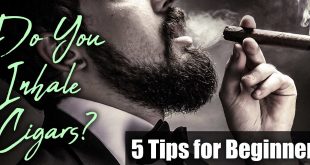How are Cigars Made? – Part 2
In our first installment of How are Cigars Made, we took a look at the motivations of cigar makers. The inspiration that fueled the creation of our favorite smokes. We also examined the heritage of the craft and the parts, pieces and layers that make up the fundamental cigar structure. In Part 2, we look at cultivation, harvest and curing of tobacco for cigars. We also touch on and production of fine cigars, which remains a handcrafted luxury in an increasingly automated world.
Cigars are Made from Fine Tobaccos
There’s an astonishing level of discernment that goes into selecting the tobaccos to be used for the finest cigars made. The wrapper always contains the highest grade of tobacco leaves, chosen for visual perfection and even color. As mentioned in part one, most cigars contain different types of tobacco often from different regions and countries.
The wrapper can make up to 90% of a cigars flavor, so cigars made by the most skilled cigar makers will have a great deal of attention paid to the wrapper leaf. Consider our own The Raji by Drew Estate. Created to celebrate Smoke Inn’s 25th anniversary and named after Raji Dababneh, the father of our owner and founder, Abe Dababneh. Coincidentally it also makes a superb Father’s Day gift. This limited-edition run was created just for us by Willy Herrera using the storied San Andrés cigar wrapper leaf.
Grown in Mexico’s San Andrés valley in the region of Veracruz, it comes from the very part of the world where the cigar itself was born from Mayan civilization. The nutrient rich volcanic soil of the San Andrés valley contributes to the robust espresso and cocoa notes of the famous leaf. The San Andrés leaf is thick and strong, making it perfect for Maduro fermentation which develops its complex flavor profile.
What About Binder and Filler Leaves?
Nicaragua is an increasingly popular source of tobacco leaves for cigars since the end of the Sandinista Revolution in the 90s restored relative peace to the region. This allowed the country to return to cultivating some of the tobacco used in the most popular fine cigars made. Nicaragua has similar, rich, dark island soil to Cuba. Estelí, Condega, and Jalapa are Nicaragua’s primary tobacco growing regions.
The lush, coal black soil of Estelí is the source of spicy Ligero binders and fillers like the zesty blend in the Tatuaje Cohetes. The Dominican Republic is also a popular source and has been for decades. The La Flor Dominicana Double Ligero DL-654 Maduro is an example of a superb cigar which features Dominican filler and binder with an Ecuadorian wrapper. The sources of binder and filler leaves are as diverse as any part of the cigar, but these two prominent examples illustrate our point perfectly.
Much of the Cigars Made in the Curing Process
Leaf selection, particularly the wrapper, has a great deal to do with flavor. But the qualities of the best cigars made are not all from the soil and sun alone. How the plant is harvested and cured, and for how long also plays a very important role. It is the nuance of all these elements that makes crafting fine cigars such an exact science. Methods and techniques are passed down generation to generation with some as closely guarded secrets.
Consider the San Andrés tobacco we mentioned earlier. Featured in the wrapper of The Raji by Drew Estate and the La Sirena Mexican Mermaid, San Andrés tobacco is stalk cut. Unlike most tobacco which is harvested by “priming” or picking the leaves off the plant a section at a time, the entire plant is harvested at once. The whole plant is then prepped to hang upside down in curing barns. The stalk-cutting and longer than usual curing time of San Andrés tobacco brings out the earthy toasted oak flavor notes that underlie the coffee-cocoa flavors they are known for. San Andrés is a strong leaf with flavors that announce themselves throughout the draw and exhale.
How are Cigars Made in a Factory?
We have seen that where the tobacco is grown, the soil and presence of shade or sun affect flavor. Harvest style and curing type and timing play an important role in how the flavors mature, enhancing the most desired traits in a particular leaf. But what about the handcrafting of the cigar itself? We’ve been very thorough in tackling how cigars made certain countries and regions famous. We paid attention to how cigars made today exist only because of the craft developed over centuries and how the cigars made in the imagination of the maker before a single leaf is rolled. These are the metaphorical aspects of cigar making though. What about the practical? Someone has to roll the leaves, right? So, what does that part look like?
The Cigars Made by Skilled Craftspeople
First leaves are sorted by color, size, strength, texture and resilience. Any veins and stems are removed. The process of harvest, curing, sorting and selecting can take several years believe it or not. But this is all by design. Nothing in cigar making is done by chance or for mere convenience. This is why we refer to cigar making as an art. It’s a time-honored tradition that has had centuries to evolve. It is a craft that results in a product whose consumers are highly discriminating and selective.
Indeed, the people who grow and produce cigars are usually aficionados themselves. From the boss and master blender down to the men and women who harvest, prep and roll the tobacco, each knows they are involved in something special. The binder or copote, in Spanish is handled by the boncheros (bunchers) along with the filler. They bunch the leaves for the torcedores (rollers)
There are several methods for rolling and these play an important role in how a cigar smokes. They are:
- BOOK BUNCH: This is the most common method used in cigars made today. Filler leaves are first stacked. Then they are folded over (sort of like pages in a book). The folded leaves are then rolled into the binder. This method is popular because it provides sufficient air flow and controlled burn and it’s faster than other techniques.
- ACCORDION: The outside of the filler leaves are folded IN, one at a time. Then all the folded leaves are laid on top of each other. This is another technique which provides very good airflow.
- ENTUBADO: This technique rolls each filler leaf into a scroll and then assembles the scrolls together inside a binder. It’s labor intensive and requires skill so you won’t see it in just any commercial grade cigar. The purpose is to expose surface area of the leaf and enhance air flow to bring aromatic vapors to your taste buds. After all, the flavor needs to reach its destination to be appreciated. The Raji by Drew Estate is an example of a fine, premium cigar with entubado bunching.
Finishing the Cigar with the Wrapper
Anyone who’s really into cigars knows how important the wrapper is. We like to say it’s how a cigar ‘introduces itself’. Because it’s the first thing you see, touch and taste. This is why cigar makers are so selective about the appearance of wrapper leaves. But also, and perhaps more importantly, because the wrapper contributes most of the flavor to the cigar. Wrapping the cigar is also the most delicate part of the assembly process requiring the most skill. The torcedor must possess a great deal of manual dexterity and precision. The leaf has to be kept tight without tearing. Rolling needs to happen at just the right angle whilst maintaining that tension. The torcedor also crafts the head of the cigar, usually cutting a cap out of the wrapper and gluing it on. The entire process is a skill that takes years to master.
Cigars Made with Care
As you can see, a lot of people are involved in the making of a fine cigar. The next time you smoke, you might think about the land where your tobacco came from. Where the leaves were grown. Imagine all the wisdom and intention that went into deciding upon the wrapper leaf. What the blend for the filler would be. Picture the skilled hands that put centuries of tradition and decades of experience into folding and rolling those leaves just so. Think about the people involved in what is truly a labor of love. They are the reason we have cigars made with such care and attention to detail today and why there is such a rich and varied selection of styles to enjoy.
Smoke Inn is Your Cigar Shop
Thanks for taking to time to join your favorite cigar shop in another journey into the rich tapestry of cigar culture. This concludes How Are Cigars Made. We hope you’re enjoying the trip and perhaps learning some things along the way. There is so much to explore about our favorite topic that we doubt we’ll ever run out of angles and approaches.
We hope to revisit tobacco cultivation and cigar production in the future, but for now we are going to move on to other areas. In our next installment of our Cigar Shop University series, for a chance of pace, we will take a look at cigar culture and famous cigar smokers. If you’re local or happen to be visiting South Florida, be sure to reward yourself with a visit to one of the countries best cigar shops, in person. We’d love to see you.
Our South Florida Locations:
 Smoke Inn Blog Smoke Inn Cigar Talk
Smoke Inn Blog Smoke Inn Cigar Talk



